Celtiberians – “They died with obstinate resolution”
The Battle of Great Plains or Campi Magni in 203 BCE was a disaster for Carthage, ultimately resulting in Hannibal being recalled from Italy to safe the day and finding his master in Scipio Africanus at Zama a year later (cf. Goldsworthy, 2003, 294-298).
At the first charge of the Roman cavalry both Carthaginian cavalry and infantry at the wings were driven from their ground, leaving exposed the centre formed by Celtiberian mercenaries. But it was here, faced with their imminent demise, that they made a name for themselves and allowed the Carthaginian and Numidian commanders Hasdrubal and Syphax to escape:
The Celtiberian line, though stripped of the support of both the wings, stood their ground; for neither did any hope of safety by flight present itself, as they were ignorant of the country, nor could they expect pardon from Scipio, against whom, though he had deserved well both of them and their nation, they had come into Africa to fight for hire. [9] Surrounded, therefore, on all sides by the enemy, they died with obstinate resolution, falling one upon another; and, while the attention of all was turned upon them, Syphax and Hasdrubal gained a considerable space of time to effect their escape.
Liv. 30.8-9
This was not a singular event, quite the opposite: Diodorus Siculus explains that “the Celtiberians advanced far in fame and were subdued by the Romans with difficulty and only after they had faced them in battle over a long period” (Diod. 5.33.1). And indeed they were one of the last to be overcome by the Romans after 200 years of upheavals and conflict on the Iberian peninsular (for campaigns in the 2nd century BCE see Quesada, 2006b).
But who were the Celtiberians? How did their panoply look like and how did they fight? I shall give an overview of the historical background of these fierce warriors and some thoughts about sculpting and painting of my – now sadly OOP – Corvus Belli Celtiberians.
Historical Background
‘Celtiberian’ is a term used by contemporaries (Diod. 5.33.3) to describe the peoples that inhabited what is today roughly Castile and Leon and Aragon (northern Spain). The late republican historian Diodorus Siculus provides in his work Bibliotheka historica an ethnogenesis:
Now that we have spoken at sufficient length about the Celts we shall turn our history to the Celtiberians who are their neighbours. In ancient times these two peoples, namely, the Iberians and the Celts, kept warring among themselves over the land, but when later they arranged their differences and settled upon the land altogether, and when they went further and agreed to intermarriage with each other, because of such intermixture the two peoples received the appellation given above.
Diod. 5.33.1
Alberro (2005, 3-4) points out that while these people spoke a celtic language, their material culture differed significantly from the La Tene culture in the north. Influences from southern Spain, especially what concerns defensive weapons, are evident. However, looking at offensive weapons, the Celtiberians could be seen as a group that influenced Iberian military equipment and transformed and innovated Celtic and Iberian weaponry, as opposed to being solely dependent on influences from surrounding ethnic groups (cf. Quesada, 2005, 63-64).

The panoply of the Celtiberians
Diodorus proceeds with a detailed description of their dress, panoply and fighting style.
And these people, it would appear, provide for warfare not only excellent cavalry but also foot-soldiers who excel in prowess and endurance. They wear rough black cloaks [σάγους μέλανας], the wool of which resembles the hair of goats. [3] As for their arms, certain of the Celtiberians, carry light shields like those of the Gauls [τῶν Κελτιβήρων Γαλατικοῖς θυρεοῖς κούφοις], and certain carry circular wicker shields as large as an aspis, and about their shins and calves they wind greaves made of hair and on their heads they wear bronze helmets adorned with purple [φοινίκεος, can also be translated as “crimson” or “red-purple”] crests. The swords they wear are two-edged and wrought of excellent iron, and they also have dirks a span in length which they use in fighting at close quarters.
Diod. 5.33.2-3
This might reflect their appearance in the 2nd century BCE, given that Diodorus wrote in the 1st century BCE (for a detailed description of the transformation of the Celtiberian panoply from the 7th to the 1st century BCE see Lorrio, 1994). Diodorus’ description does not conflict with the archaeological evidence or pictorial representations (e. g. the Liria vases), but naturally organic material is less likely to be preserved, accordingly we have only his word for the black of the cloaks, the red of the crests and the greaves of hair (potentially sinew or textile).
While it is difficult to achieve a true black with ancient dying agents a greyish black could be easily achieved using charcoal or mineral dyes. Iberia was famous for its production of red dyes (see my post on Iberian Scutati for more details) so a crimson or purple-red crest is not unlikely. As always, I would be careful interpreting this description as some kind of uniform. Each warrior would have to equip himself, mending weapons and cloth alike, probably exchanging equipment while on campaign or supplementing it with booty. While some warriors might have worn black cloaks and red crests, it is very unlikely that there was any uniformity what concerns garments.
Fighting style
Armour and weapons reflect a certain fighting style and should thus be much more uniform throughout a group of warriors. We learn of the use of two kinds of shields: the thureos and a round shield. It is of importance that Diodorus is not describing a caetra here, much rather a sizeable round shield of similar dimensions to an aspis.
This is a first hint that the Celtiberian warriors did not usually engage in guerilla tactics, but rather open field battles. The old notion that Iberian warriors were in general unable to oppose Roman forces in a pitched battle due to their preference of guerilla tactics is a remnant of earlier, now corrected, scholarship (cf. Quesada, 2011, 48).
However, it seems that Lusitanians did excel in this fighting style given the rough terrain they inhabited (cf. Meister, 2007, 382ff.). Quesada (2006, 6ff.) shows convincingly that not only did Iberian and Celtiberian warriors prefer open field battles, but also that their fighting style and panoply was very similar to that of their Roman opponents. He argues that Roman maniples did not fight in neatly dressed rectangular ranks, but rather
in dense ‘clouds’ … this formation is still a recognizable one, keeping a strict unit and sub-unit system, and using the all-important standards as focal points. … This is also not a dense skirmish line, but a battle line, although its centurions would not be much concerned with keeping regular ranks once fighting started, but just with having men grouped round their standards and ready to expand and compress their ranks.
Quesada,2006, 7
It stands to reason, that Iberian units fought in a similar fashion, given that our sources do not stress differences as they, for instance, do when describing the fighting style of phalangites in comparison to the Roman soldier. However, Quesada concludes: “That the Iberians and Celtiberians were finally beaten was due to the superior structure, organization, logistics and probably numbers of the Roman armies…, not to inferior weapons or small unit tactics” (Quesada, 2011, 52).

The Gladius Hispaniensis
The quality of the iron the Celtiberians used for their arms was renowned in the ancient world as Diodorus (5.33.4) and Polybios (Fragment XXII (96)) attest. Especially their swords were highly regarded:
The Celtiberians excel the rest of the world in the construction of their swords; for their point is strong and serviceable, and they can deliver a cut with both edges.
Pol. XXII (96)
The design was well suited to fighting in close quarters, so much so that the Romans adopted this so-called Gladius Hispaniensis after the Second Punic War due to its superior properties (Pol. XXII (96)). Archeological evidence suggests that this form of offensive weapon originated in Celtiberia, but was based on La Tene swords imported throughout the 3rd century BCE and substantially modified according to local tastes (cf. Quesada, 1997, 266-268). However, the falcata, often seen as the signature Iberian offensive weapon, was not widely spread in the Celtiberian cultural area (Quesada, 2011, 49).
Solifera
Javelins or solifera were also used by the Iberians and Celtiberians alike. Being the inspiration for the Roman pilum – yet another design the Romans successfully adopted and improved on – it was well suited for a fierce exchange of missile weapons. Zhmodikov (2000,70-71) suggest that this exchange could have gone on for a long period of time, moving the emphasis from close quarter hand-to-hand combat to a continuous renewal of ranged combat. This would also speak against traditional ideas of a single initial shower of projectiles followed by a charge into close combat. Literary evidence suggests that the use of missile weapons was not limited to a few seconds before close combat began and played a much larger role in combat than previously assumed (cf. the collection of sources in Zhmodikov, 2000, 68-70 and Quesada, 2006a, 3-4).
Pectorals – achy breaky heart
Interestingly mail armour was not prevalent in Celtiberia according to the archeological record, even so it was well liked by the Celts and Romans (cf. Quesada, 2005, 65-66). Instead pectorals were in use. Once again this will have changed on campaign and it is not unlikely that warriors adopted mail while fighting in southern France or in Africa.

Masters of the horse
We also find some information about signature manoeuvres of the Celtiberians in Diodorus, Livius and Polybios. They describe them as being able to fight in two styles: on horseback and dismounted should the situation require it:
Able as they are to fight in two styles, they first carry on the contest on horseback, and when they have defeated the cavalry they dismount, and assuming the role of foot-soldiers they put up marvellous battles.
Diod. 5.33.5
The Celtiberians have a peculiar manoeuvre in war. When they see their infantry hard pressed, they dismount and leave their horses standing in their places. They have small pegs attached to their leading reins, and having fixed them carefully into the ground, they train their horses to keep their places obediently in line until they come back and pull up the pegs.
Pol. XXI (95)
Celtiberians – light infantry?
We alos learn about the ability of the Celtiberians to fight in rough terrain:
Even in their winter quarters the Romans were not allowed much quiet; the Numidian horse were roaming in all directions, or where the ground was too rough for them, the Celtiberians and Lusitanians.
Liv. 21.57.5
This must not suggest that the Celtiberians were in general light infantry, but might allude to light infantry being present amongst the Celtiberians. A comparison of the fighting style of Lusitanians and Celtiberians in Diodorus further emphasises the role of the latter as heavy infantry:
They [the Lusitanians] also use barbed javelins made entirely of iron, and wear helmets and swords very much like those of the Celtiberians. They hurl the javelin with good effect, even over a long distance, and, in fine, are doughty in dealing their blows. Since they are nimble and wear light arms, they are swift both in flight and in pursuit, but when it comes to enduring the hardships of a stiff fight they are far inferior to the Celtiberians.
Dio. 5.34.5
The Cuneus
Finally we read in Livius at several occasions of a peculiar manoeuvre that was able to force back or even break a line of Roman heavy infantry:
When the Spaniards saw the two Roman divisions on their side of the river, they decided to engage them before they could form a united front, and swarming out of their camp they rushed down to battle. [2] The fighting began very fiercely, as the Spaniards were full of spirit after their recent victory, and the Romans were smarting under their unwonted humiliation. [3] The Roman centre, formed by two of the bravest legions, fought most gallantly, and the enemy finding themselves unable to dislodge them in any other way, formed themselves into a wedge and thus massed, the ranks behind always more numerous than those in front, they forced the centre back.
Liv. 39.31.1-3
This wedge formation (cuneus) was apparently very effective and could even overcome the might of the Roman legion:
When the Celtiberi found that their regular order of battle made them no [3] match for the legions, they bore down upon them in wedge-formation, a maneuver which gives them such weight that in whatever direction they carry their attack it cannot be withstood. Even the legions were now thrown into disorder and the Roman line was all but broken.
Liv. 40.40.2-3
While the Celtiberians were surely formidable opponents, in the end they lacked the drill, discipline and organisation of the Roman legion leading often to defeat, even though they were able to beat the Roman infantry momentarily in close quarters. In the example above the Roman cavalry managed to interrupt the wedge and turn the tide of battle at the last minute.
Nevertheless, it is quite interesting that despite their inability to beat the Romans in a series of pitched battles, they never ceased to offer them. Quesada suggests that this preference for pitched infantry battles as opposed to guerilla tactics was finally not in favour of the Celtiberians and Iberians at large and led to their ultimate demise (Quesada, 2006a, 13). However, it also proves that Celtiberians were without a doubt effective heavy infantry and were a match for the Roman legionary.
The Miniatures: Sculpting and Historical Accuracy
The now OOP Corvus Belli Celtiberians convince in all categories: Good detail, believable poses, good variety of poses and proportions look alright for 15mm. The flash was ok with these miniatures and there was no case where mold halves shifted or flash went right through the face. I also did not have any miscasts.
The miniatures are supplied with thureoi and big round shields. A sensible selection that reflects the literary evidence. Some of the Celtiberians sport cloaks, but not all of them. They look in general very similar to the Iberian Scutati, but some have trousers instead of tunics. I don’t think it can be said with any certainty if the Celtiberians wore trousers, but once again on campaign I don’t see why they would not adopt a new style if it proved to be more comfortable or better suited for a particular climate.
They are equipped with both swords and spears, which can make it tricky to properly line the unit up as the spears will protrude to the back and front. I kept this in mind when I glued them on the bases, but it is a fiddly affair. Most of the swords are straight and presumably depict the gladius hispansiensis. A few of the miniatures wield a falcata. Given that very few falcata were found in the Celtiberian cultural area this is a sensible choice and on campaign it is likely that both weapons were in use. However, if we consider how many warriors one miniature represents it might be that the falcata could appear too prevalent, but I personally don’t mind.
A number of the miniatures wear mail, so they are better suited for an “on campaign” look during the Second Punic War. It would have been better to feature some pectorals, given that mail was not used much in the Celtiberian cultural area and this choice limits the miniatures’ versatility.
Finally the miniatures are either bare-headed, or equipped with Montefortino style helmets, some with, some without cheek guard. The so-called Hispano-Chalcidian helmet (cf. Graells, Lorrio & Quesada, 2014) is not represented. A sensible choice, as this type of helmet got more and more out of use during the 3rd century BCE (cf. Graells, Lorrio & Perez Blasco, 2015, 99-101) with the Montefortino type becoming more prevalent during the Second Punic War. Once again this indicates the timeframe these miniatures are ment for, with a strong preference for the Punic Wars.
Painting
I went for a colourful mix of reds, blues, greens, browns and off-whites for the tunics to represent the fact that each warrior had to equip himself. The reasoning behind the colour choices is very similar to what I wrote about available pigments in my post on Iberian Scutati.
The shield devises often provide contrasting colours to the tunics and were inspired by the Liria vases. Here I wanted to show Iberian and Celtic influences, after all they were in contact with both and I like to think this lead to an eclectic mix of shield designs.
Helmets and pectorals I painted bronze, with spearheads, blades and mail being iron.
To reflect the literary sources I painted some crests red and also went for some black cloaks. I think the cloaks provide a nice contrast to the other equipment.
I hope you enjoyed this short introduction to military aspects of the Celtiberian culture and got inspired to start your own force. If you have any general comments, suggestions or would like to add something to the historical discussion, please feel free to comment below.
References:
Primary sources:
Appian. The Foreign Wars. Horace White [Trans.]. New York: Macmillan, 1899.
Diodorus Siculus. Book V. C. H. Oldfather [Trans.]. Cambridge, MA: Harvard University Press, 1933-1967.
Livy. History of Rome. Canon Roberts [Trans.]. New York, New York: E. P. Dutton and Co. 1912.
Polybius. Histories. Evelyn S. Shuckburgh [Trans.]. London, New York: Bloomington, 1962.
Strabo. The Geography of Strabo. Literally translated, with notes, in three volumes. London: George Bell & Sons, 1903.
Secondary literature:
Alberro, M. (2005). The Celticity of Galicia and the Arrival of the Insular Celts. Proceedings of the Harvard Celtic Colloquium, Vol. 24/25, 1-15.
Goldsworthy, A. (2003). The Fall of Carthage: The Punic Wars 265-146BC. London: Cassell.
Graells, R. I, Lorrio A. J., Perez Blasco, M. F. (2015). A new Fragment of a Hispano-Chalcidian Helmet from Castillejo (Prov. Soria) in the RGZM. Archäologisches Korrespondenzblatt, 45.1, 91-104.
Graells, R.,· Lorrio, A. J., & · Quesada, F. S. (2014). Cascos hispano-calcídicos. Símbolo de las elites guerreras celtibéricas. Mainz: Verlag des Römisch-Germanischen Zentralmuseums.
Lorrio, A. J. (1994). La evolucion de la panoplia celtiberica. Madrider Mitteilungen, 35, 212-257.
Meister, Florian (2007). Der Krieg des Sertorius und seine spanischen Wurzeln: Untersuchungen zu Krieg und Akkulturation auf der Iberischen Halbinsel im 2. und 1. Jh. v. Chr. Hamburg: Dr. Kovac.
Quesada, F. S. (2011). Guerrilleros in Hispania? The myth of Iberian guerillas against Rome. Ancient Warfare, 2, 46-52.
──── (2006a). Not so different: individual fighting techniques and small unit tactics of Roman and Iberian armies. In: P. François, P. Moret & S. Péré-Noguès (Eds.), L’Hellénisation en Méditerranée Occidentale au temps des guerres puniques. Actes du Colloque International de Toulouse, 31 mars-2 avril 2005, Pallas, 70 (pp. 245-263).
──── (2006b). Los celtiberos y la guerra: tacticas, cuerpos, efectivos y bajas. Un analisis a partir de la campana del 153. In F. Burillo (ed.), Segeda y su contexto historico. Entre Caton y Nobilior (195 al 153 a.C.). Zaragoza: Centro de Estudios Celtibéricos de Segeda.
──── (2005). Patterns of interaction: ‘Celtic’ and ‘Iberian’ weapons in Iron Age Spain (pp. 56-78). In W. Gillies and D. W. Harding (eds.), Celtic Connections: Papers from the Tenth International Congress of Celtic Studies, Edinburgh, 1995. Edinburgh: University of Edinburgh.
──── (1997). Gladius hispaniensis: an archaeological view from Iberia. Journal of Roman Military Equipment Studies, 8, 251-270.
Zhmodikov, A. (2000). Roman Republican Heavy Infantrymen in Battle (IV-II Centuries B.C.). Historia: Zeitschrift für Alte Geschichte, 49.1, 67-78.

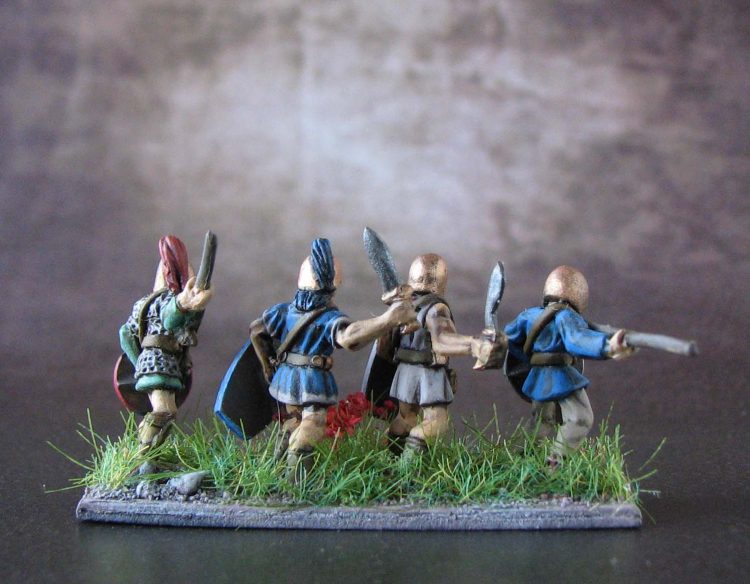


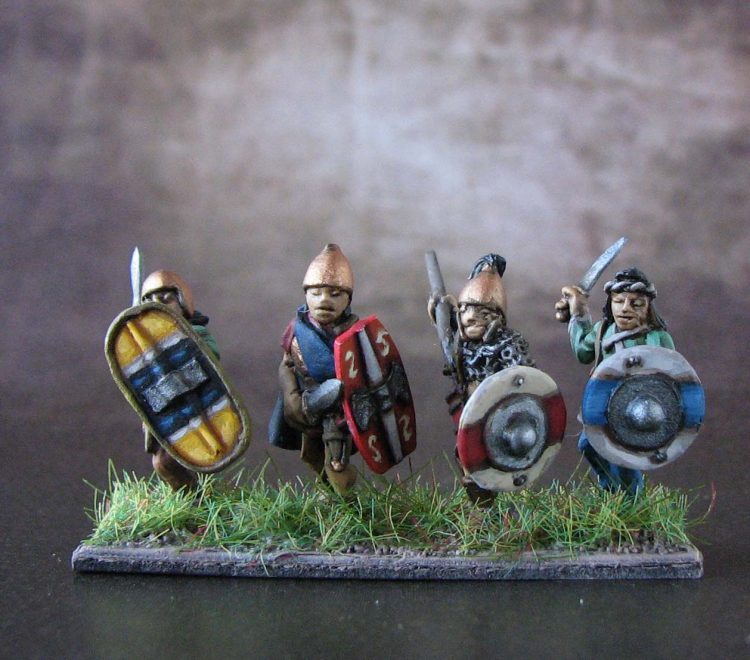
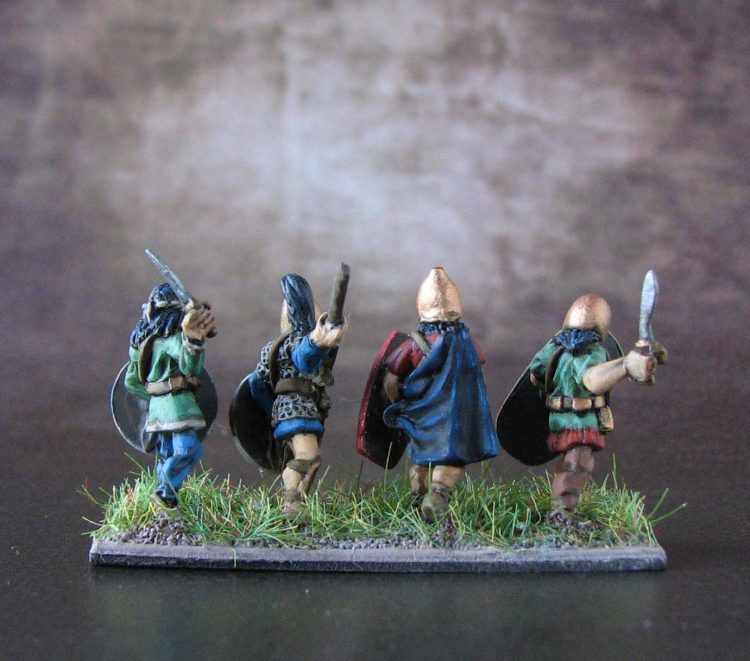

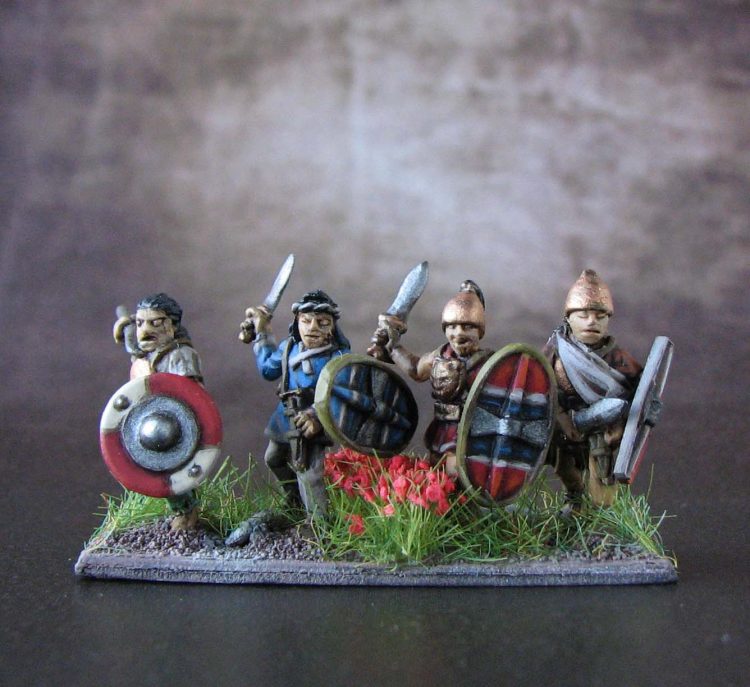

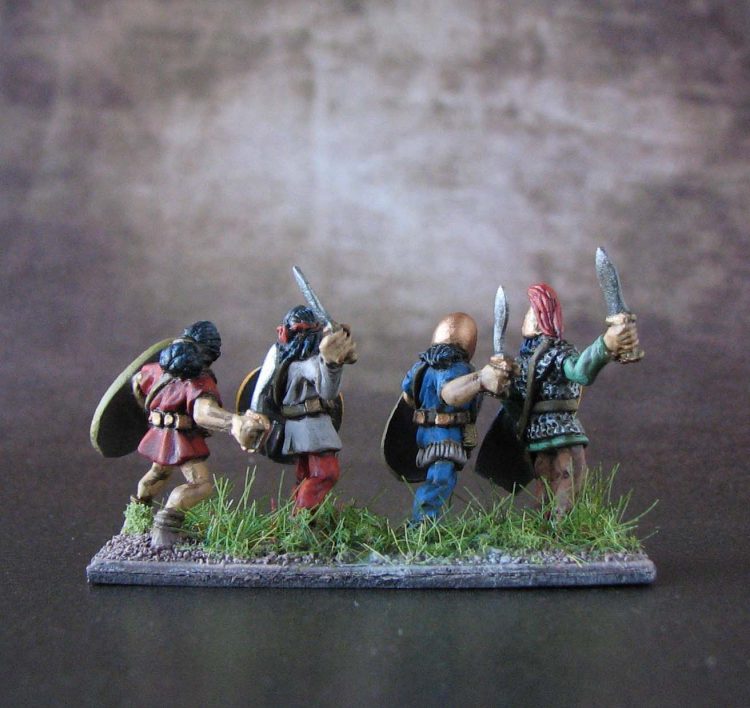
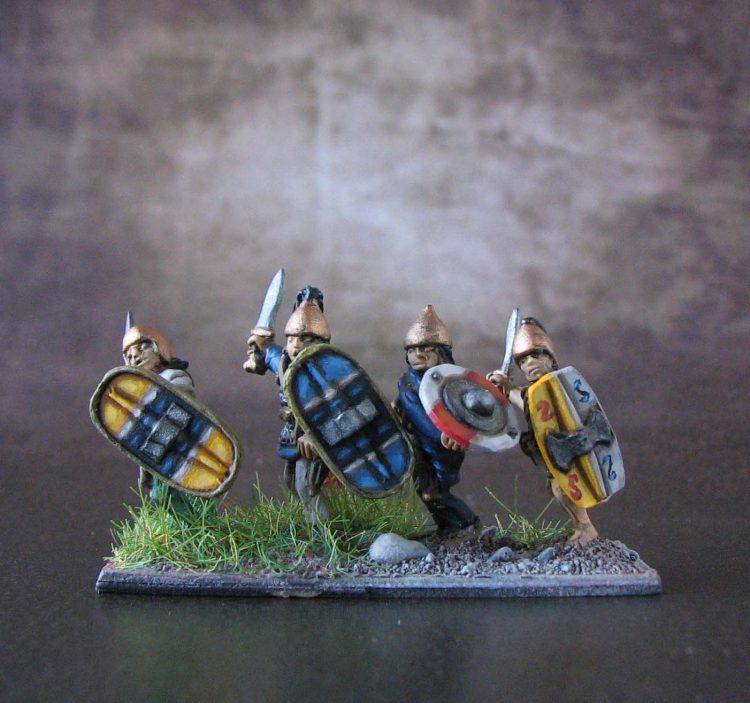
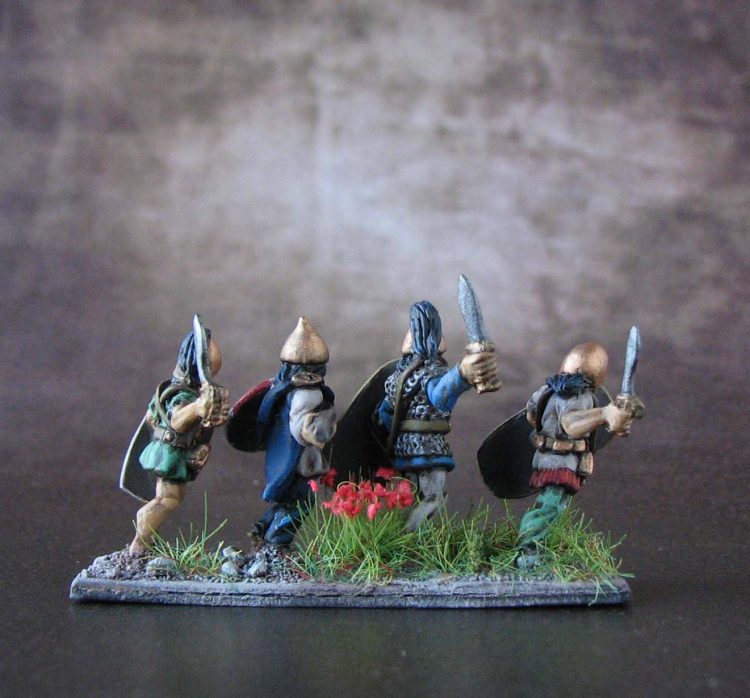
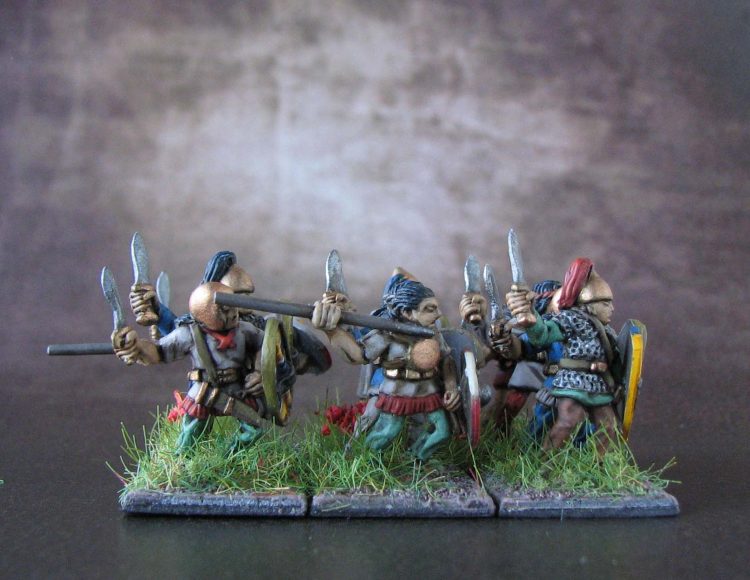

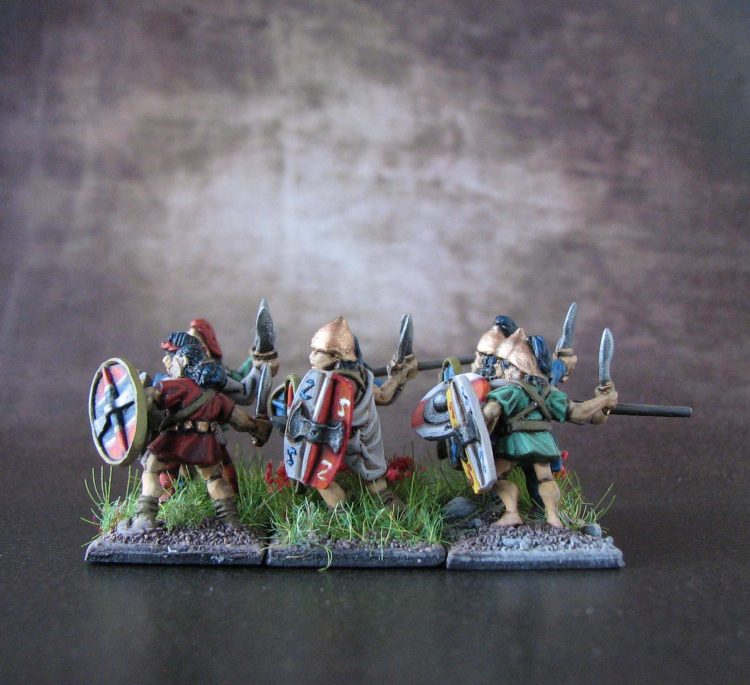
The background is great already, but the minis are really top notch, especially taking into account they are 15mm!
Thank you Burkhard, much obliged. 15mm might be fiddly, but I think they still deserve a reasonable paint job. Given that I focus on Carthaginians and Republican Romans (at a later stage) only, that works for me. However, I can see that other people focus more on having many playable armies while not having to worry about storage space.
Perhaps the “Greaves of Hair” were something woven,. shaped and hardened with another material? After all, paper armour is a thing and all manner of materials have been used in warfare. On the other hand, they might have been primarily decorative or even top-layer covers for other materials.
Thank you for chiming in. I think you are right. I could see sinew being used, as they used it for helmets/caps, too. Decorative fur on top might be an idea, no matter the material. The coats might have been quite ‘hairy’, too, so from a fashion point of view they would go well together ;). I don’t think this is at all represented on the models and if they have greaves they are made of metal. Thus it does not influence my painting :).
Thanks for the research and the excellent write-up. Very interesting!
Also, the figures, scenes, and photography are superb, though maybe you fell down a bit in representing the greaves made of hair (I’m kidding!).
Good to see a post from you.
Thank you Arkiegamer. Glad you like the article. I was unfortunately very busy the past couple of months, so while I wrote a bit here and there it took me a while to finish a new post. Gladly I have no a bit more time and intend to increase my post output accordingly.
Beware going off a tangent here: Yes, that whole greaves of hair buisness puzzels me. I don’t see how you could make a greave out of hair, but maybe they saw sinew strands and thought, hey that looks like hair or maybe you can really make a proper defensive weapon out of hair. I don’t think it is a translation problem either, as in the greek it uses τρίχινος: “of hair”. Gladly this must not be of concern to me, as my guys took the metal greaves of the Romans they defeated on campaign ;).
Looting dead Romans removes all sorts of problems!
I’m intrigued by the hair greaves, as well. I can see tightly bundled hair causing weapons to rebound, sort of like hard rubber, and certainly the loss of kinetic energy would lessen the effect of a blow. Maybe the hair was woven into cables and/or laminated, somehow?
Fascinating story and great paint job on the figures! It’s always exciting to learn more about the Punic Wars.
Thank you for your comment. Glad you liked it. In terms of classic campaigns I think the Punic Wars are one if the most interesting struggles. I think it is mainly due to the charismatic protagonists on each side, variety of troops in action and scale of these wars, ending in the destruction of one opponent. So all one needs for a story as epic as any movie or even more so.